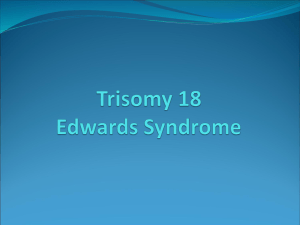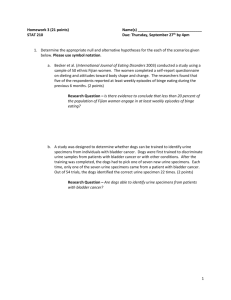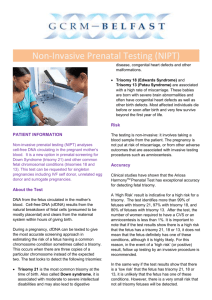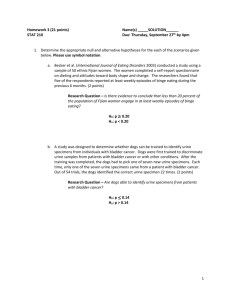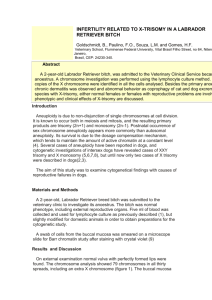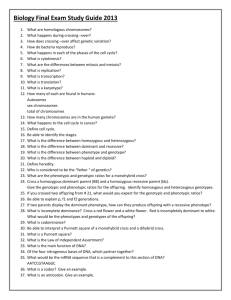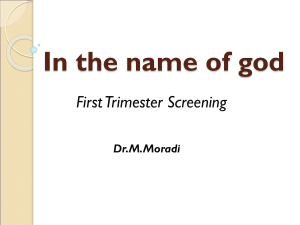TRISOMY 18 - e
advertisement
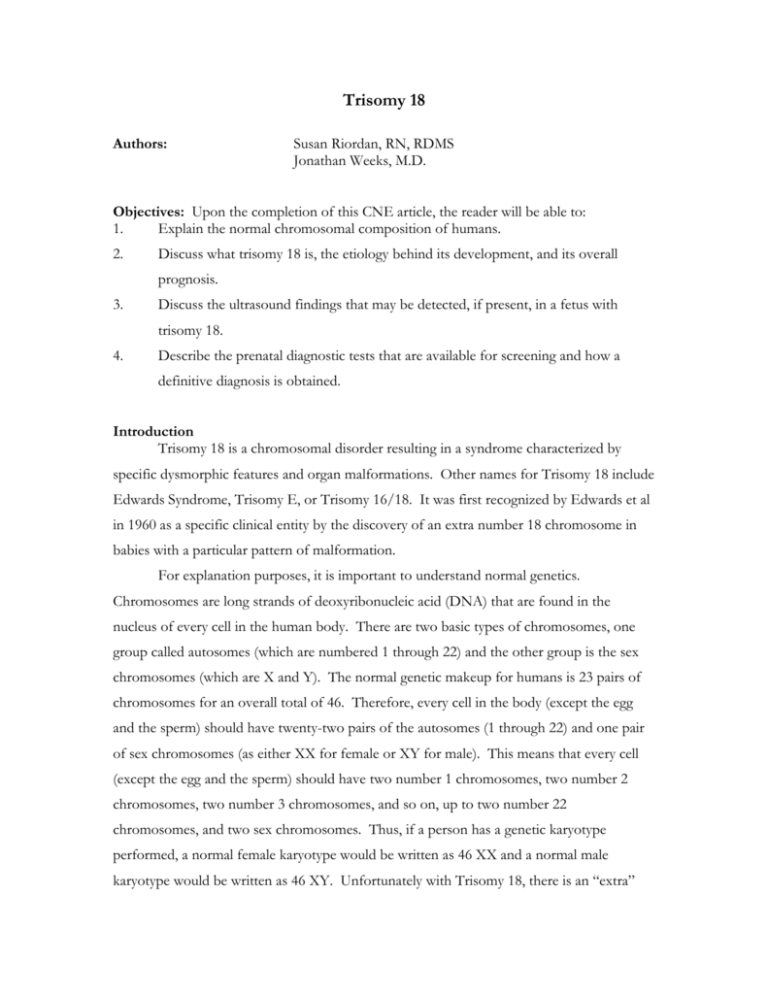
Trisomy 18 Authors: Susan Riordan, RN, RDMS Jonathan Weeks, M.D. Objectives: Upon the completion of this CNE article, the reader will be able to: 1. Explain the normal chromosomal composition of humans. 2. Discuss what trisomy 18 is, the etiology behind its development, and its overall prognosis. 3. Discuss the ultrasound findings that may be detected, if present, in a fetus with trisomy 18. 4. Describe the prenatal diagnostic tests that are available for screening and how a definitive diagnosis is obtained. Introduction Trisomy 18 is a chromosomal disorder resulting in a syndrome characterized by specific dysmorphic features and organ malformations. Other names for Trisomy 18 include Edwards Syndrome, Trisomy E, or Trisomy 16/18. It was first recognized by Edwards et al in 1960 as a specific clinical entity by the discovery of an extra number 18 chromosome in babies with a particular pattern of malformation. For explanation purposes, it is important to understand normal genetics. Chromosomes are long strands of deoxyribonucleic acid (DNA) that are found in the nucleus of every cell in the human body. There are two basic types of chromosomes, one group called autosomes (which are numbered 1 through 22) and the other group is the sex chromosomes (which are X and Y). The normal genetic makeup for humans is 23 pairs of chromosomes for an overall total of 46. Therefore, every cell in the body (except the egg and the sperm) should have twenty-two pairs of the autosomes (1 through 22) and one pair of sex chromosomes (as either XX for female or XY for male). This means that every cell (except the egg and the sperm) should have two number 1 chromosomes, two number 2 chromosomes, two number 3 chromosomes, and so on, up to two number 22 chromosomes, and two sex chromosomes. Thus, if a person has a genetic karyotype performed, a normal female karyotype would be written as 46 XX and a normal male karyotype would be written as 46 XY. Unfortunately with Trisomy 18, there is an “extra” number 18 chromosome, and the karyotype would be listed as 47 XY, +18 (for a male) or 47 XX, +18 (for a female). To explain further, the autosomes are categorized into groups (designated by letters) based on size and appearance, which are: Group A chromosomes 1, 2 and 3 Group B chromosome 4 and 5 Group C chromosomes 6 through 12 Group D chromosomes 13, 14 and 15 Group E chromosomes 16, 17, and 18 Group F chromosomes 19 and 20 Group G chromosomes 21 and 22 This helps to explain the other names for the syndrome, namely trisomy E or trisomy 16/18, based on their grouping category; whereas, the name Edwards Syndrome comes from the researcher that first discovered the anomaly. Etiology As discussed above, trisomy 18 is a genetic abnormality that is caused by the presence of an extra number 18 chromosome. The incidence of Trisomy 18 is about 1 in 3000 pregnancies, but is approximately 1 in 8000 live births. It is the second most common autosomal trisomy behind trisomy 21. However, it is the most common chromosomal anomaly found in stillbirth infants (most of which are not clinically suspected as being a trisomy). If born alive with this trisomy, it is more commonly seen in females versus males at a ratio of 3 to 1. It is also one of the more common trisomies seen in first trimester spontaneous abortions (or miscarriage). Approximately 80% of the cases are the result of a primary meiotic nondisjunction (where there is a failure of the chromosomes to separate during metaphase). Approximately 10% of cases are referred to as mosaicism, which is most often caused by a post-zygotic mitotic nondisjunction. This usually leads to only a partial expression of the trisomy 18 and these children are usually less severe and have a longer survival. The remaining 10% is caused by a chromosome translocation. This is where one of the number 18 chromosomes is stuck to some other chromosome, which increases the chance that the sperm or the egg will obtain an extra copy during meiosis. Prenatal Diagnosis The prenatal diagnosis of trisomy 18 may be suggested by an abnormal triple marker blood test. The triple marker blood test consists of the maternal serum alpha-fetoprotein level (MSAFP), the human chorionic gonadotropin (HCG) blood level, and the blood level of unconjugated estriol. This triple marker test is offered to prenatal patients between 15 and 20 weeks’ gestational age. The test is also used to screen for trisomy 21, however, the pattern of the blood test results is distinctly different. For trisomy 18, all three blood test results are significantly decreased (whereas for trisomy 21, the MSAFP and estriol values are decreased but the HCG level is significantly elevated). It is not completely clear as to why this pattern occurs in trisomy 18. If a triple marker blood test is performed and the result is suggestive of trisomy 18, the patient should then be scheduled for genetic counseling by a genetic counselor, geneticist, or perinatologist. Once this is completed, a targeted ultrasound will most likely occur. The individual performing the ultrasound should be aware of the anomaly patterns and types of malformations that could be suggestive of a chromosomal abnormality. If abnormalities are detected on the ultrasound examination, the patient may then be counseled regarding the advantages / disadvantages of an amniocentesis to confirm or rule out the possibility of trisomy 18. An amniocentesis can be performed at any gestational age; however, if the patient desires the possibility of choosing a pregnancy termination (if the karyotype returns abnormal), the procedure is usually performed prior to 21 weeks gestation. For an amniocentesis, the karyotype results may take 7 to 14 days to return. If results are desired sooner, percutaneous umbilical blood sampling (PUBS) may be offered, whereby blood is directly collected from the umbilical cord of the fetus. This can produce results within a couple of days; however, the procedure is more risky to the fetus than an amniocentesis. If a karyotype is performed and returns with a diagnosis of trisomy 18, some patients may choose to end the pregnancy. Others, however, may choose to continue the pregnancy in which case non-intervention is usually practiced and no “heroic” measures are taken to save the baby because of the very poor prognosis (as will be discussed below). Ultrasound Findings If trisomy 18 is suspected based on triple marker screening, approximately 70% of cases will reveal the presence of anomalies seen by ultrasound (from subtle to major abnormalities). If a trisomy 18 fetus progresses into the second half of pregnancy the majority will display intrauterine growth restriction (IUGR) of a symmetrical type. This means that all measurement parameters lag behind what is expected. Of trisomy 18 babies delivered at term, the average birthweight is about 2300 grams (compared to about 3000 grams for non-trisomy babies). In addition, the amniotic fluid volume will usually be normal or even increased, a finding that is inconsistent with asymmetrical IUGR. Over 100 different anomalies have been described in cases of trisomy 18 fetuses. The discussion below covers the more common findings that may help in identifying a fetus that is suspected of having trisomy 18. The anomalies that are associated with trisomy 18 can be seen in all parts of the baby including the head, thorax, abdomen, and extremities. Regarding the fetal brain, head, spine, and neck, the following anomalies may be seen: agenesis of the corpus callosum, choroid plexus cysts (especially if they persists into the 2nd half of the pregnancy) (figures 1 & 2), posterior fossa abnormalities, a large cisterna magnum (defined as > 10mm), holoprosencephaly, ventriculomegaly, a strawberry-shaped skull (flattening of the occiput with a narrowing of the frontal bones seen in about 50% of cases), microcephaly, micrognathia (a small lower jaw seen in up to 50% of cases on profile), low set “fawnlike” pointed ears, cleft lip and/or palate, meningomyelocele, and cystic hygroma or edema around the neck. Regarding the extremities, the following may be seen: clenched hand with overlapping fingers (fingers two and five overlap fingers three and four – seen in 50% of cases) (figure 3), rocker-bottom feet (seen in about 33% of cases) (figure 4), clubfeet, generalized arthrogryposis (joint contractures), syndactyly (webbed fingers or toes), and reduction of forearm length. The fetal chest anomalies include diaphragmatic hernia, esophageal atresia with or without tracheoesophageal fistula, and cardiac anomalies (seen in over 90% of cases). The cardiac anomalies may include aortic coarctation, ventricular septal defect (VSD), atrial septal defect (ASD), transposition of the great vessels, persistent left superior vena cava, dextrocardia, hypoplastic left ventricle, tetralogy of Fallot, and atrioventricular canal defect. The defects of the fetal abdomen include the abdominal wall, the umbilical cord, and the kidneys. The abdominal wall and umbilical cord defects include omphalocele (reported to occur in about 33% of cases) (figure 5), a single umbilical artery (noted in 30% of cases – the umbilical cord has one artery and one vein instead of two arteries and one vein) (figure 6), and prune-belly syndrome. The fetal kidney anomalies may include horseshoe kidney (seen in 33% of cases), hydronephrosis (figure 7), ectopic kidney, polycystic kidney, and double ureter. Prognosis: The prognosis for a fetus with trisomy 18 is very poor. The risk of miscarriage or stillbirth is very high. If the baby is born alive, about 25% will die within the first few hours or days of life and approximately 90% will die before the age of one. However, it is important for families to understand that some trisomy 18 babies can live for several years and thus the diagnosis is not completely lethal. After delivery, trisomy 18 newborns may have respiratory difficulties with apnea, often have a weak cry, and commonly have a poor suck with feeding problems and failure to thrive. Other problems often include: hypotonia (poor muscle tone), severe mental retardation (almost universal), gastrointestinal reflux, seizures, kidney problems, and scoliosis. Management: As would be expected, most parents are devastated when a diagnosis of trisomy 18 is suspected and then confirmed by karyotype. Since the prognosis is so poor, many parents will choose to end the pregnancy, if possible. It is important to emphasize to the parents that this disorder is genetic and is not caused by something they may have done nor is it the result of poor prenatal care. Many parents will feel guilty and blame themselves; however, nothing can be done to “fix” the anomaly or change the diagnosis. If the patient chooses to continue the pregnancy, fetal distress is often seen during the labor process. In addition, these babies often deliver prematurely. A cesarean section, however, should be avoided because the risks to the patient are far greater than any potential benefit that may be seen by the trisomy 18 baby (due to its extremely poor prognosis). Once delivered, the parents should be given the opportunity (if desired) to be alone and bond as if it were a “normal” baby. If significant external anomalies are seen by ultrasound, it is important to remember that the physical appearance of the newborn may be frightening or shocking to the parents if they are not adequately prepared before the delivery. If genetic counseling was not performed during the pregnancy, it should definitely be recommended before the conception of any future pregnancies. The recurrence risk depends on the chromosomal aberration. If the trisomy 18 is caused by nondisjunction that occurred during meiosis (where there is 47 individual chromosomes with an extra number 18), the recurrence rate is about 1%. However, if the parents are carriers of a balanced translocation, the recurrence risk is increased to approximately 10%. Figures 1 A view of the fetal choroid plexus revealing bilateral single cysts (the fetus had trisomy 18) 2 A view of the fetal choroid plexus revealing bilateral numerous cysts (the fetus did not have trisomy 18) 3 An image of a fetal hand that is clenched with the outer fingers overlapping the inner fingers in a fetus with trisomy 18 4 An example of a rocker-bottom foot in the same fetus as in figure number 3 5 An image of an omphalocele (the fetus did not have trisomy 18) 6 An example of a two-vessel cord (one artery and one vein – the fetus did not have trisomy 18) 7 An image that depicts hydronephrosis (also seen in the same fetus as number 1 with trisomy 18) References or Suggested Reading: 1. Fleischer A, Manning F, Phillippe J, Romero R. Sonography in Obstetrics and Gynecology. 1996. 2. Harrison M, Golbus M, Filly R. The Unborn Patient. 1990. 3. Chervenak F, Isaacson G, Campbell S. Ultrasound in Obstetrics and Gynecology. Volume 2, 1993. 4. Edwards JH, Harnden DG, Cameron AH, Crosse VM, Wolff OH. A new trisomic syndrome. Lancet 1960;1:787. 5. Callen P. Ultrasonography in Obstetrics and Gynecology. 1994. 6. Benacerraf B. Ultrasound of Fetal Syndromes. 1998. 7. Reece A, Hobbins J, Mahoney M, Petrie R. Medicine of the Fetus and Mother. 1992. 8. Bauld R, Sutherland GR, Bain AD. Chromosome studies in investigation of stillbirths and neonatal deaths. Arch Dis Child 1974;49:782. 9. Creasy R, Resnik R. Maternal-Fetal Medicine, 1994. 10. Gabbe S, Niebyl J, Simpson JL. Obstetrics: Normal and Problem Pregnancies. 1996. 11. Romero R, Pitu G, Jeanty P, Ghidini A, Hobbins J. Prenatal Diagnosis of Congenital Anomalies. 1988. 12. Simpson JL, Golbus MS, Martin AO, Sarto GE. Genetics in Obstetrics and Gynecology. 1982. 13. DeVore GR. Second trimester ultrasonography may identify 77 to 97% of fetuses with trisomy 18. J Ultrasound Med 2000;19:565-76. 14. McGahan JP, Porto M. Diagnostic Obstetrical Ultrasound. 1994. 15. Brumfield CG, Wenstrom KD, Owen J, Davis RO. Ultrasound findings and multiple marker screening in trisomy 18. Obstet Gynecol 2000;95:51-4. About the Authors Susan Riordan received her Bachelors degree in nursing in 1979 and has been a full time nurse for 21 years. She has worked in labor and delivery, postpartum, and the newborn nursery. She has been a high-risk obstetrical sonographer for the past 10 years and received her RDMS in Obstetrics and Gynecology in 1997. She currently works at Norton Suburban Hospital in Maternal-Fetal Medicine under the direction of Dr. Jonathan Weeks. Jonathan Weeks, M.D. is a board certified Obstetrician / Gynecologist and Perinatologist. He is currently director of the Maternal Fetal Medicine Center at Norton Suburban Hospital. Dr. Weeks has several publications in peer-review medical journals and has lectured at numerous meetings across the country. Examination: 1. In the normal genetic makeup for humans, A. there are 46 pairs of total B. there are 22 pairs of autosomes C. females are designated as XY D. every cell in the body including the egg and the sperm have 46 chromosomes E. males are designated as XX 2. The karyotype for a male fetus with trisomy 18 would be listed as follows A. 47 XY, +18 B. 46 XY, +18 C. D. E. 47 XX, +18 46 XX, +18 47 +18 3. Trisomy 18 has other names, one of which is trisomy E. This name is derived from A. Dr. Edwards who discovered the chromosomal anomaly B. the fact that 18 anomalies were initially reported when it was first discovered C. the Greek letter “eta” D. its grouping category E. the fact that it was the fifth trisomy discovered with the first four being lettered A, B, C, and D. 4. The incidence of Trisomy 18 is about _______ live births. A. 1 in 3,000 B. 1 in 5,000 C. 1 in 8,000 D. 1 in 10,000 E. 1 in 15,000 5. Regarding trisomy 18, all of the following are true EXCEPT A. It is the second most common autosomal trisomy behind trisomy 21. B. It is the most common chromosomal anomaly found in stillbirth infants. C. If born alive with this trisomy, it is more commonly seen in males versus females. D. It is one of the more common trisomies seen in first trimester spontaneous abortions (or miscarriage). E. The incidence is about 1 in 3000 pregnancies. 6. Approximately _____ of the cases of trisomy 18 are the result of a primary meiotic nondisjunction (where there is a failure of the chromosomes to separate during metaphase). A. 10% B. 25% C. 50% D. 65% E. 80% 7. The triple marker blood test consists of the A. MSAFP, HCG, and CBC B. MSAFP, CBC, and estriol C. TSH, HCG, and estriol D. MSAFP, HCG, and estriol E. TSH, MSAFP, and HCG 8. Regarding the triple marker screen, the pattern of the blood test results for trisomy 18 reveals that A. all three values are significantly decreased B. the MSAFP and HCG values are decreased but the estriol is elevated C. D. E. the MSAFP and estriol values are decreased but the HCG is elevated the HCG and estriol values are decreased but the MSAFP is elevated all three values are significantly increased 9. If a genetic amniocentesis is performed, the karyotype results may take _____ to return. A. 4 to 10 hours B. 12 to 24 hours C. 2 to 3 days D. 4 to 6 days E. 7 to 14 days 10. If trisomy 18 is suspected based on triple marker screening, approximately ______ of cases will reveal the presence of anomalies seen by ultrasound (from subtle to major abnormalities). A. 90% B. 70% C. 50% D. 40% E. 25% 11. Regarding the anomalies of the fetal brain, head, spine, and neck for trisomy 18, all of the following may be seen EXCEPT A. agenesis of the corpus callosum B. a large cisterna magnum defined as > 1mm C. ventriculomegaly D. micrognathia E. cystic hygroma or edema around the neck 12. Approximately ______ cases of trisomy 18 will have a strawberry-shaped skull, which is flattening of the occiput with a narrowing of the frontal bones. A. 90% B. 70% C. 50% D. 40% E. 25% 13. For trisomy 18, approximately 50% of cases will have clenched hands with overlapping fingers, characterized as A. fingers two and five overlapping fingers three and four B. fingers three and four overlapping fingers two and five C. fingers three and four overlapping finger one D. fingers two and four overlapping fingers three and five E. finger one overlapping finger two 14. Regarding the cardiac anomalies (seen in over 90% of trisomy 18 cases), all of the following may be seen EXCEPT A. ventricular septal defect B. C. D. E. dextrocardia aortic coarctation transposition of the great vessels persistent right superior vena cava 15. For trisomy 18, the defects of the fetal abdominal wall, umbilical cord, and kidneys include all of the following EXCEPT A. omphalocele (reported to occur in about 33% of cases) B. hydronephrosis C. horseshoe kidney (seen in 33% of cases) D. a two-vessel cord with only two arteries and no vein (noted in 30% of cases) E. prune-belly syndrome 16. Regarding the prognosis for a fetus with trisomy 18, if the baby is born alive, about _______ will die before the age of one. A. 25% B. 40% C. 50% D. 70% E. 90% 17. It is important for families to understand that some trisomy 18 babies can live for several years and thus the diagnosis is not completely lethal. After delivery, trisomy 18 newborns may have all of the following EXCEPT A. respiratory difficulties with apnea B. feeding problems and failure to thrive C. hypotonia (poor muscle tone) D. severe mental retardation (but fortunately this is rare) E. gastrointestinal reflux and kidney problems 18. All of the following statements regarding trisomy 18 are true EXCEPT A. Since the prognosis is so poor, many parents will choose to end the pregnancy, if possible. B. It is important to emphasize to the parents that this disorder is genetic and is not caused by something they may have done but is probably the result of poor prenatal care. C. Many parents will feel guilty and blame themselves; however, nothing can be done to “fix” the anomaly or change the diagnosis. D. If the patient chooses to continue the pregnancy, fetal distress is often seen during the labor process. E. A cesarean section should be avoided because the risks to the patient are far greater than any potential benefit that may be seen by the trisomy 18 baby (due to its extremely poor prognosis). 19. Regarding future pregnancies, the recurrence risk is _____ if the trisomy 18 is caused by nondisjunction that occurred during meiosis (where there is 47 individual chromosomes with an extra number 18). A. 1% B. C. D. E. 20. 5% 10% 25% 50% Regarding future pregnancies, the recurrence risk is _____ if the parents are carriers of a balanced translocation. A. 1% B. 5% C. 10% D. 25% E. 50%


